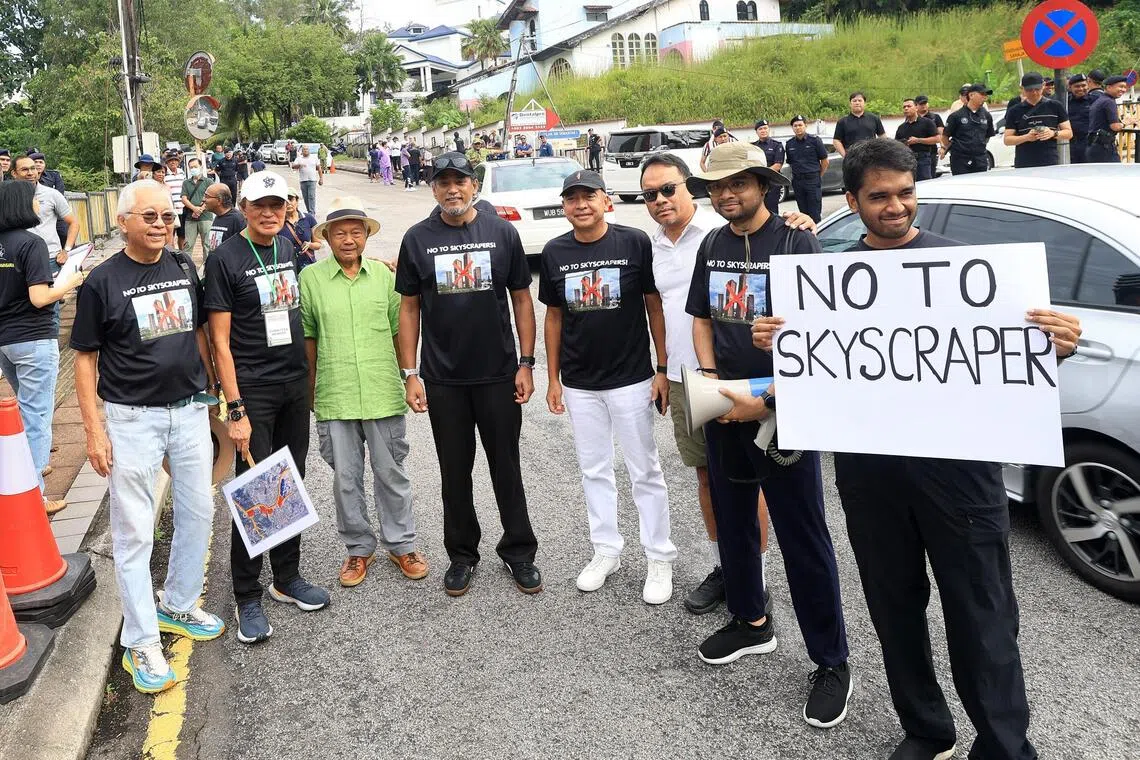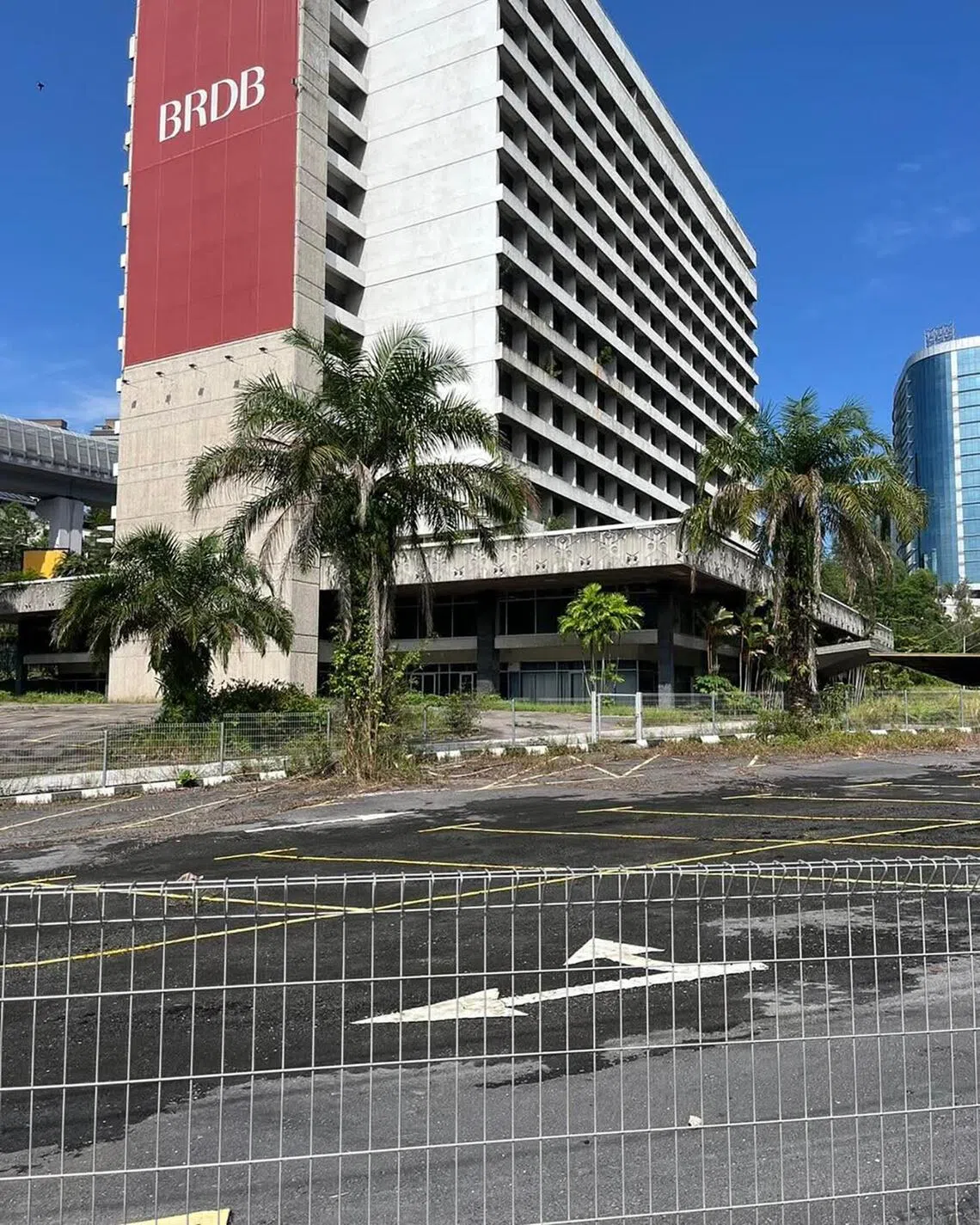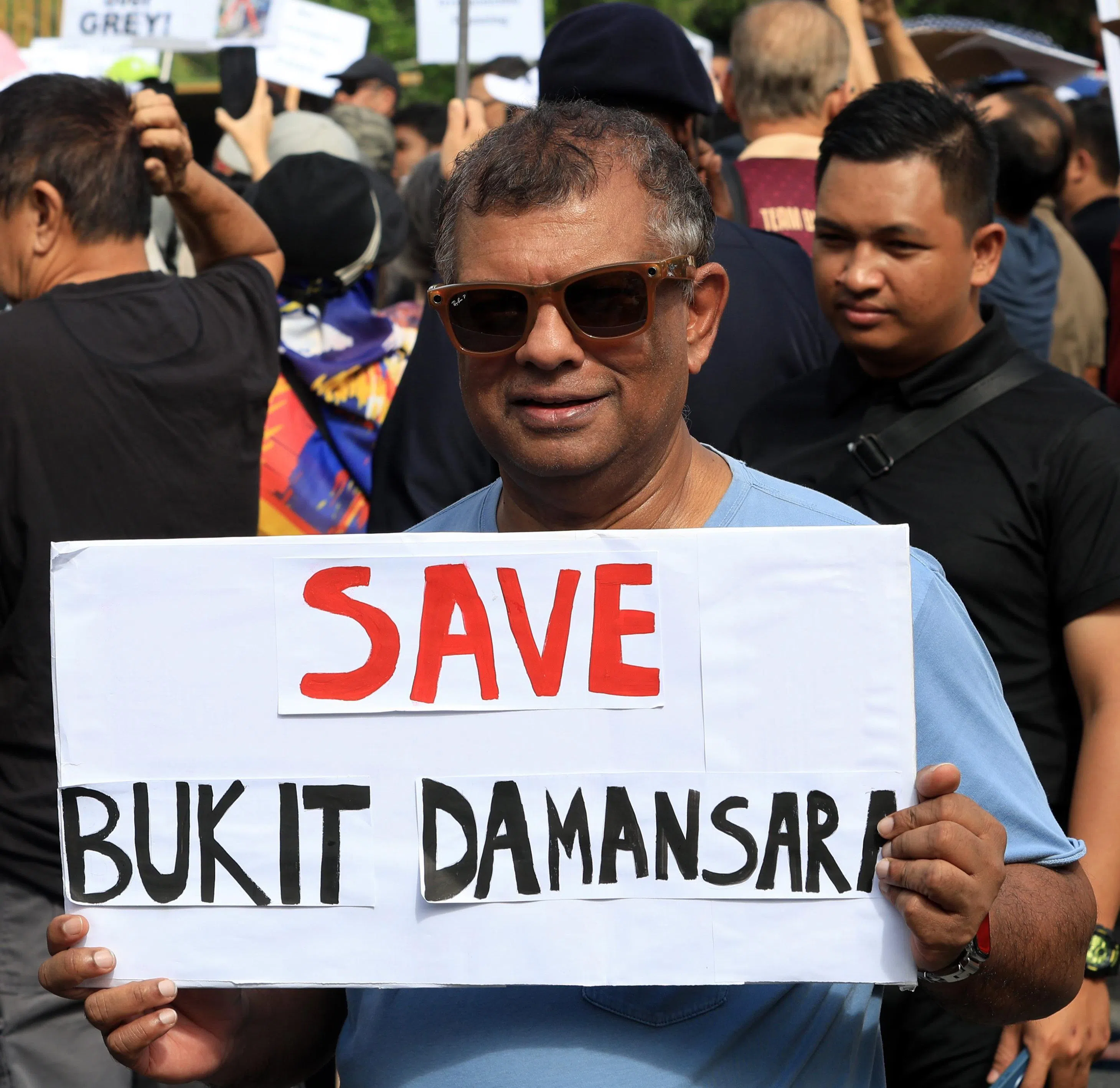Protest in the ‘Beverly Hills of Malaysia’ sparks anti-elitist backlash
Sign up now: Get ST's newsletters delivered to your inbox

Former Malaysian Cabinet minister Khairy Jamaluddin (fourth from left) and ex-chief of CIMB financial group Nazir Razak (fifth from left) during a protest against the redevelopment of the Wisma Damansara office building into two skyscrapers.
PHOTO: THE STAR/ASIA NEWS NETWORK
Follow topic:
- Bukit Damansara residents, including former minister Khairy Jamaluddin, protested against a proposed a high-rise project, citing concerns about traffic and preserving the area's suburban character.
- The protest faced online backlash, with many Malaysians accusing the "elites" of hypocrisy and being out of touch with ordinary citizens' struggles.
- Experts say the backlash reflects growing anti-elitist sentiment and rising awareness of inequality in Malaysia, potentially leading to demands for fairness.
AI generated
KUALA LUMPUR - Bukit Damansara or Damansara Heights is one of Kuala Lumpur’s most prestigious addresses. Also known as the “Beverly Hills of Malaysia”, the affluent and upscale neighbourhood is home to many of the nation’s elites. So, when as many as 300 residents led by former minister-turned-political podcaster Khairy Jamaluddin gathered to protest against a proposed high-rise project in their midst, the online backlash was swift.
On Oct 4, Mr Khairy and dozens of other Bukit Damansara residents assembled next to Wisma Damansara to protest against the planned redevelopment of the neglected building on main road Jalan Semantan into two 60-storey towers.
Wisma Damansara, built in 1970, was the first commercial office building in the Bukit Damansara area and, at one point, housed several United Nations agencies.
“For the past 30 years, we have been willing to share Bukit Damansara with others... but there must be limits,” Mr Khairy said.
While noting the need for growth and development, the long-time resident of Bukit Damansara said its suburban character must be preserved.
“Can you imagine the pressure on Jalan Semantan, already a choke point for traffic? I want to ask if DBKL (Kuala Lumpur City Hall) has conducted a proper traffic study for the plot ratio granted to (developer) BRDB. How much can Jalan Semantan realistically handle?” he said during the peaceful “Say No to Skyscrapers” rally.
Public reaction, however, was far from sympathetic – reflecting a shifting mood that is increasingly intolerant of perceived elitism and entitlement.
Instead of support, the protest drew a torrent of backlash online, with many Malaysians mocking what they saw as privileged outrage where the rich defend their comfortable status quo while ordinary citizens grapple with rising rents, worsening traffic and a shortage of affordable housing.
News of the proposed mixed-use redevelopment project first emerged in March. Following the recent protest, DBKL clarified that the project remains under review. Yet, the statement has done little to ease public criticism of Bukit Damansara’s residents.
Those who attended the rally included AirAsia founder Tony Fernandes, former CIMB Group chairman Nazir Razak, lawyer and activist Ambiga Sreenevasan, and Malaysia’s “Queen of Jazz” singer Sheila Majid.
Bukit Damansara, once primarily home to government officials, now boasts multimillion-ringgit mansions, high-end restaurants and members-only clubs. Home prices range from RM4 million (S$1.2 million) to RM20 million or more, depending on the size and type of property.
For decades, Bukit Damansara residents have enjoyed suburban privacy just 5km from the city centre. And they want the continued convenience of urban connectivity, without the attendant density and overcrowding.
Netizens sniffed at the hypocrisy of the “not-in-my-backyard” (Nimby) set. On social media, commenters noted how the “elites” seldom mobilise when overdevelopment affects other parts of the capital city – such as Cheras and Puchong, congested and overbuilt with high-rise flats; or when Kampung Sungai Baru residents were evicted from their homes in September after the land was acquired to build a luxury condominium.
“The rich protest not because their lands were seized but because they do not want to view skyscrapers,” one wrote.
Another netizen commented: “Now they know how residents of Cheras, Puchong, Kepong, Jinjang and Sri Petaling feel... just keep building apartments that will look down on the swimming pools in their (elites’) backyard.”
Experts say the backlash reflects a deeper social shift and rising anti-elitist sentiment, with public discourse gradually shifting from ethnicity to class.
Professor Awang Azman Awang Pawi, from the Department of Socioculture and Arts at Universiti Malaya, said the discontent expressed online is a telltale sign of a broader social shift in the country.
“This discontent is not just about perception but reflects structural inequality,” he told The Straits Times.
“People are questioning how some live in luxury, while others face housing and economic pressures. It is also part of a longstanding frustration with elites who seem disconnected from everyday realities.”
That public backlash has been amplified online because netizens now have platforms to express dissent that previously would have remained private, he added. Terms like “Bangsar bubble” and “Putrajaya elite”, once niche expressions, have also entered everyday conversation, reflecting rising awareness of inequality.
Ms Dina Zaman, co-founder of Iman Research, a local think-tank studying society, religion and social trends, noted that resentment towards the elites has been simmering for years, particularly among young Malaysians.
“In (an) interview in 2015, young people often spoke about feeling left behind. They told us it was because they did not have ‘connections’,” she said.

Wisma Damansara on Jalan Semantan, Kuala Lumpur, the site of a proposed redevelopment that would replace the plot with two 60-storey buildings.
PHOTO: BUKIT DAMANSARA HOUSE OWNER ASSOCIATION
“They were talking about a system that rewards who you know, not what you can do. That sense of exclusion is very real,” she added.
Associate Professor Tunku Mohar Mokhtar, a political analyst from the International Islamic University Malaysia, said the public backlash also reflects growing class consciousness, highlighted by official income categories such as T20, M40 and B40 (referring to the top 20 per cent, middle 40 per cent and bottom 40 per cent of Malaysian household incomes).
“These categories frame inequality discussions. When people from elite neighbourhoods take a stand to protect their interests while others struggle with daily costs, it triggers a strong reaction,” he said.
He added that public discourse is gradually shifting from ethnicity to class. Wealth, privilege and access to power are now under scrutiny.
The Bukit Damansara protest, although rooted in urban planning concerns, has become part of a wider conversation about empathy, inequality and who gets to be heard when they claim to be wronged.
The Zara Qairina case, where a 13-year-old student allegedly bullied by her peers died in July, also sparked public anger amid claims of a cover-up.

AirAsia chief Tony Fernandes holding a placard on Oct 4, during a protest against the redevelopment of the Wisma Damansara office building into two skyscrapers, in Kuala Lumpur's elite neighbourhood of Bukit Damansara.
PHOTO: THE STAR/ASIA NEWS NETWORK
“People ask: What about ordinary citizens? Why should privilege shield wrongdoing?” Ms Dina said.
Datuk Awang Azman said: “The Zara Qairina case has become a microcosm of a new social representation crisis, where young people no longer idolise wealth as they did in the 2000s, but instead value authenticity, honesty and social concern. In this context, anger is not directed at individuals alone, but at social structures that allow a few to live in luxury amid growing inequality.”
Such anti-elite sentiment, if ignored, could escalate, he said.
“If structural inequalities, privilege and power remain unchecked, these discontented sentiments could manifest more visibly, not as anger alone but as a demand for fairness, transparency and equality in access to opportunities,” he added.
Sign up for our weekly
Asian Insider Malaysia Edition
newsletter to make sense of the big stories in Malaysia.


